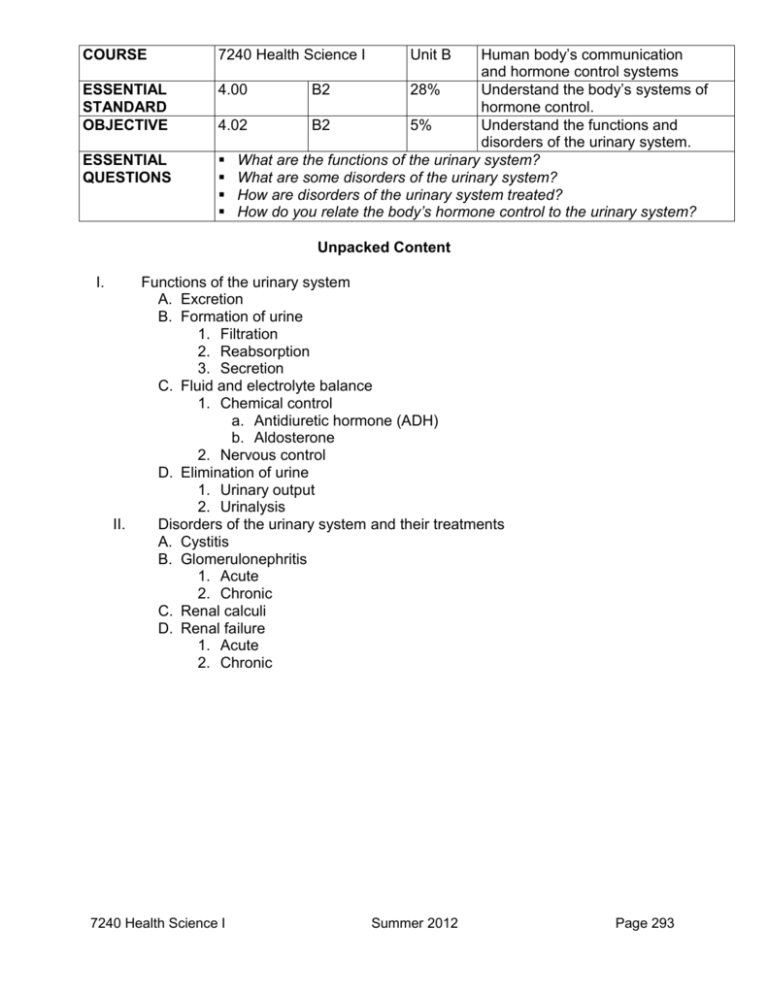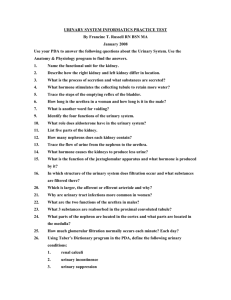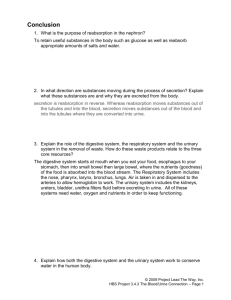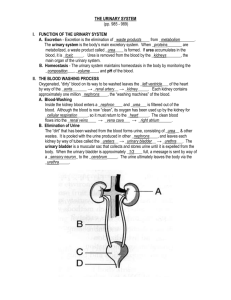4.02
advertisement

COURSE ESSENTIAL STANDARD OBJECTIVE ESSENTIAL QUESTIONS Human body’s communication and hormone control systems 4.00 B2 28% Understand the body’s systems of hormone control. 4.02 B2 5% Understand the functions and disorders of the urinary system. What are the functions of the urinary system? What are some disorders of the urinary system? How are disorders of the urinary system treated? How do you relate the body’s hormone control to the urinary system? 7240 Health Science I Unit B Unpacked Content I. II. Functions of the urinary system A. Excretion B. Formation of urine 1. Filtration 2. Reabsorption 3. Secretion C. Fluid and electrolyte balance 1. Chemical control a. Antidiuretic hormone (ADH) b. Aldosterone 2. Nervous control D. Elimination of urine 1. Urinary output 2. Urinalysis Disorders of the urinary system and their treatments A. Cystitis B. Glomerulonephritis 1. Acute 2. Chronic C. Renal calculi D. Renal failure 1. Acute 2. Chronic 7240 Health Science I Summer 2012 Page 293 ACTIVITIES 1. 2. 3. Functions of the Nephron Students will use their nephron model from objective 4.01 for this activity. Place students in pairs to review nephron structures. Paired students will then label the nephron model with its function. The teacher will circulate around the classroom to correct misconceptions. Students will use their nephron models as a study tool. Functions of the Urinary System Present PowerPoint presentation slides 1-29. Discuss with students how urine formation occurs while reviewing models with each group. Students will refer to their nephron model while participating in class discussion. Students will record notes and class discussion in their notebooks. Hormone Control of the Urinary System Distribute the handout. Assign the skit for students to present on another class day. Students should follow the directions as presented on the handout. Allow students some class time to prepare for the skit, if 7240 Health Science I RELEVANCY TO OBJECTIVE RESOURCES Students will UNDERSTAND 4.01 Nephron Model (B2) the functions of the urinary system. Textbook and any other teacher approved resource Labels 4.02 Understand the Students will UNDERSTAND (B2) the functions of the urinary functions and disorders of the urinary system system. PowerPoint Presentation, slides 1-29 Student notebooks Students will UNDERSTAND 4.02 Hormone Control (B2) the functions of the urinary of the Urinary System system. Skit Handout Summer 2012 Page 294 ACTIVITIES 4. 5. 6. time permits, otherwise use this activity as a homework assignment. Students should be able to dress up to present their function. Pathway of Urine Formation Note: Prepare Pathway of Urine Flow Cards ahead of time. Make enough sets to accommodate the number of students in your class. Distribute to cards to students as they enter the classroom. Have student line up in the proper order (and in the appropriate shape if applicable) of the urine formation process. Students should state what process occurs at their point of the formation of urine. Repeat as often as needed until students understand the process of urine formation. Hormone Control of the Urinary System Review In pairs, have students discuss how urine production is affected by (1) dehydration (2) decreased BP (3) excess intake of caffeine (4) excess intake of salt Facilitate discussion and clear any misconceptions. Urinary System Matching Distribute the handout. Have students complete the handout as assigned. Collect the handouts as 7240 Health Science I RELEVANCY TO OBJECTIVE RESOURCES 4.02 Pathway of Urine Students will UNDERSTAND (B2) the functions of the urinary Formation Cards system. 4.02 Understand the Students will UNDERSTAND (B2) the functions of the urinary functions and disorders of the urinary system system. PowerPoint Presentation, slides as needed Students will UNDERSTAND 4.02 Urinary System (B2) the functions of the urinary Matching Quiz system. Summer 2012 Page 295 ACTIVITIES 7. 8. students complete the quiz. Grade and return the quizzes on the next class day. Review the quizzes with the class to clear up misconceptions. Urinary System Key Terms Place the students in pairs. Distribute the handout. Have each pair of students discuss the terms and the relevance of that function to health. Pair each pair of students with another pair to discuss the terms and the relevance of that function to health. Facilitate discussion by asking: o When do you think a urinary catheterization is used? o Have students infer which terms relate to the use of a urinary catheter. Answer questions as presented by the students. Students will use the handout as a study tool. Disorders of the Urinary System Distribute the handout. Present the PowerPoint presentation, slides 30-48. Facilitates discussion. Have students record their notes and class discussion on the handout. Students will use the handout as a study tool. 7240 Health Science I RELEVANCY TO OBJECTIVE RESOURCES Students will UNDERSTAND (B2) the relevance of urinary function to health. 4.02 Key Terms Related to Urinary System Functions Students will UNDERSTAND (B2) disorders of the urinary system and their impact on health. 4.02 Understand the functions and disorders of the urinary system PowerPoint Presentation, slides 30-48 4.02 Urinary System Disorders Handout Summer 2012 Page 296 ACTIVITIES 9. Medical Decisions Distribute the handout. Place students in groups of 3-4. Students will complete the activity using HOSA Creative Problem Solving guidelines. Review the guidelines with the class. Upon completion, allow students to present who gets the kidney and the rationale for the decision. Use the competitive event rating sheet to evaluate each group. 10. What do you think happened? Distribute the handout. Instruct students to complete the handout as directed. Upon completion, review answers with class. Facilitate discussion and clear up misconceptions. 11. 4.02 Understand the functions and disorders of the urinary system Assessment Distribute the assessment. Allow students the class time to complete the assessment. Grade papers and return to students as soon as possible. 12. 4.03 Remember the structures of the endocrine system Preparation Assign students to use their 7240 Health Science I RELEVANCY TO OBJECTIVE RESOURCES Students will UNDERSTAND (B2) disorders of the urinary system and their impact on health. 4.02 Medical Decisions Handout Students will UNDERSTAND (B2) disorders of the urinary system and their impact on health. 4.02 What do you think happened? Handout HOSA Guidelines: Creative Problem Solving http://www.hosa.org/na torg/sectb/cativ/cps.pdf Students will UNDERSTAND (B2) the urinary system. 4.02 Understand the functions and disorders of the urinary system Assessment as prepared by the teacher or as provided Students will REMEMBER (A1) the structures of the endocrine system. Textbook Summer 2012 Notebook Page 297 ACTIVITIES RELEVANCY TO OBJECTIVE textbooks to read about the endocrine system. Students should be given an assignment to complete to facilitate learning. Note: This could be an assignment from the materials provided or as provided by the teacher.) Review and return these materials to students prior to beginning the next objective. 7240 Health Science I RESOURCES OR Materials provided Summer 2012 Page 298 4.02 Let Me Entertain You! Skit Handout Name ________________ Date _________________ Directions: 1. The teacher will assign groups of 3-5 students. 2. Working in your group, write a skit using the terms listed below. The skit may or may not pertain to the urinary system; however, the use of the terms has to indicate your understanding of them. 3. Present the skit to the class. 4. The skit should demonstrate thorough knowledge of the following processes: Diffusion Filtration Osmosis Reabsorption Secretion 5. The teacher may want to video the skits to share with other students, parents, Open House events, or school TV news report. 7240 Health Science I Summer 2012 Page 299 4.02 Urinary System Matching Quiz Handout Name _________________ Date __________________ Directions: Match the following terms and with their functions. _____ 1. Retroperitoneal A. The process of removing nitrogenous waste material, certain salts, and excess water from the blood. _____ 2. Excretion _____ 3. Nephron B. Performs filtration _____ 4. Glomerulus C. The opposite of reabsorption _____ 5. Filtrate D. The basic structural and functional unit of the kidney. _____ 6. Secretion E. Located behind the peritoneum. F. Under the control of the hypothalamus, this hormone increases the permeability of water in distal and collecting tubules G. A hormone released by the kidneys when blood pressure drops. _____ 11. Proximal convoluted tubules H. A fluid consisting of water, glucose, amino acids, some salts and urea. _____ 12. Filtration I. An examination of the urine _____ 13. Bladder J. Stores urine until about 500cc has accumulated _____ 14. ADH K. The first step in urine formation _____ 15. Cortex L. Adrenal hormone that controls urinary secretion M. Contains the nephrons N. Where 80% of the water filtered out of the blood by the glomerulus is reabsorbed O. They increase urinary output by inhibiting the reabsorption of water. _____ 7. Urinalysis _____ 8. Aldosterone _____ 9. Diuretics _____ 10. Renin 7240 Health Science I Summer 2012 Page 300 4.02 Urinary System Matching Quiz Handout KEY Name _________________ Date __________________ Directions: Match the following terms and with their functions. __E__ 1. Retroperitoneal A. The process of removing nitrogenous waste material, certain salts, and excess water from the blood. B. Performs filtration C. The opposite of reabsorption D. The basic structural and functional unit of the kidney. E. Located behind the peritoneum. F. Under the control of the hypothalamus, this hormone increases the permeability of water in distal and collecting tubules G. A hormone released by the kidneys when blood pressure drops. __G__ 10. Renin H. A fluid consisting of water, glucose, amino acids, some salts and urea. __N__ 11. Proximal convoluted tubules I. An examination of the urine __K__ 12. Filtration J. Stores urine until about 500cc has accumulated __J__ 13. Bladder K. The first step in urine formation __F__ 14. ADH L. Adrenal hormone that controls urinary secretion __M__ 15. Cortex M. Contains the nephrons N. Where 80% of the water filtered out of the blood by the glomerulus is reabsorbed O. They increase urinary output by inhibiting the reabsorption of water. __A __ 2. Excretion __D__ 3. Nephron __B__ 4. Glomerulus __H__ 5. Filtrate __C__ 6. Secretion __I___ 7. Urinalysis __L__ 8. Aldosterone __O__ 9. Diuretics 7240 Health Science I Summer 2012 Page 301 4.01 Key Terms Related to Urinary System Functions Handout Key Term Definition anuria absence of urine diuretic drug that increases urinary output dysuria painful urination enuresis bedwetting filtrate fluid that has passed through a filter glycosuria presence of glucose in urine hematuria presence of blood in urine incontinence involuntary urination micturate to urinate nephralgia pain in a kidney neurogenic bladder nocturia damage to the nerve that controls the bladder frequent urination at night oliguria reduced production of urine polyuria excessive urination pyuria pus in the urine uremia urinalysis presence of urinary waste products in the blood examination of the urine urinary catheterization urinary retention insertion of a sterile tube into the urinary bladder inability to urinate urinate emptying of urine from the urinary bladder emptying of urine from the urinary bladder void 7240 Health Science I Summer 2012 Name _________________ Date __________________ Relevance to Health Page 302 4.02 Urinary System Disorders Handout Name ________________ Date _________________ Directions: Record notes and class discussion about urinary system disorders while viewing the Power Point Presentation. Use this handout as a study tool. Urinary System Disorders Cystitis ___________ ___________ ___________ ___ ___________ ___ Acute ________________ ________________ ________________ Glomerulonephritis __________________ __________________ __________________ ______ Renal Calculi ________________ ________________ ________________ Chronic ________________ ________________ ________________ _ Acute _______________ _______________ _______________ _______________ _______________ __ Renal Failure ____________________ ____________________ ____________________ ____ Chronic _______________ _______________ _______________ _______________ _______________ Other notes: ___________________________________________________________ ______________________________________________________________________ ______________________________________________________________________ ______________________________________________________________________ ______________________________________________________________________ ______________________________________________________________________ ______________________________________________________________________ 7240 Health Science I Summer 2012 Page 303 ______________________________________________________________________ ______________________________________________________________________ 4.02 Medical Decisions Handout Directions: Name ____________________ Date _____________________ You have been assigned to a Medical Decisions Board for a university hospital. Today, your decision involves a very common dilemma: four patients in complete renal failure, all in need of a kidney transplant and there is only one kidney. Your assignment is to determine who gets the available kidney? Your teacher will inform you of the due dates for each part of the process. Date ______ Read information about kidney transplants, either in your textbook, in other class print materials, in your school’s media center, or on the Internet Date _______ Work with your group using the guidelines for HOSA’s Creative Problem Solving event to determine who gets the kidney. Date _______ Present your decision and rationale to a group of judges or your class. All of the following patients are compatible recipients for the kidney to be transplanted. The kidney donor was a 17 year old male who was killed in a car crash. The parents have requested that the kidney be transplanted in a teenager. 7240 Health Science I Summer 2012 Page 304 Name, Age and Occupation Mary Greaves 54 Housewife Michelle Mantle 35 Former tennis pro Renal Status Dialysis: 15 years Transplant waiting list: 7 years Dialysis: 1 year Transplant waiting list: 6 months Phyllis Puckett 19 College student Dialysis: 2 years Transplant waiting list: 9 months Geri Sanchez 43 Auto mechanic Dialysis: 7 years Transplant waiting list: 2 years Other Medical factors Financial Status Arthritis Post-menopausal hormone replacement Hypertension Overall health – Fair Multiple sclerosis – 2 years – Mod. Overall health – Fair $46,000/yr Medicaid Overall health – Good Regularly uses cocaine, other illegal substances have been present in blood specimens Overall health – Excellent Social Factors Net worth – 20 million dollars No insurance Parents: $120,000/y r Blue Cross/Blue Shield $25,000/yr Managed care – will cover 50% of costs 4.02 What do you think happened? Handout Has 6 grown kids, all supportive Husband is reformed alcoholic with stable income and in good health, age 60 High profile patient would bring much media attention to the medical center Potential exists for financial gain for the medical center, publicity for organ donations Parents are supportive Patient resists medical regimen as prescribed by physicians Has 16 year old son in school who lives in the home Wife died of Leukemia in 1995 Name ____________________ Date _____________________ Directions: Read each scenario. Based on your understanding of the structure and function of the urinary system, what do you think has happened? 1. Taylor is on the track team at school. After running a mile on a very hot day, Taylor went to the bathroom to urinate, and was concerned that there was a very small amount urine and the color was deep amber. Explain why this happened. ________________________________________________________________ ________________________________________________________________ ________________________________________________________________ ________________________________________________________________ ________________________________________________________________ 7240 Health Science I Summer 2012 Page 305 2. Carlos was playing football and was hit pretty hard in his right flank area. Later that night, when he urinated, he noticed the water in the toilet bowl was light pink. What could have caused this? Should he be alarmed? Explain your answer. ________________________________________________________________ ________________________________________________________________ ________________________________________________________________ ________________________________________________________________ ________________________________________________________________ 3. Carla’s grandmother had a CVA and was hospitalized. When Cara went to visit her grandmother, and saw a clear plastic bag filled with urine hanging on the side of the bed. A tube leading from the bag went to her grandmother. Why does Carla’s grandmother have this device? What purpose does it serve? ________________________________________________________________ ________________________________________________________________ ________________________________________________________________ ________________________________________________________________ ________________________________________________________________ 4. Whitney went to camp. After a few days there, she began to have dysuria, and noticed that her urine smelled unusual and was cloudy. What might her symptoms indicate? ________________________________________________________________ ________________________________________________________________ ________________________________________________________________ ________________________________________________________________ ________________________________________________________________ 4.02 Prototype Assessment Items Note: These items illustrate the types of items used in the item bank for this objective. All items have been written to match the cognitive process of the understand verb in the objective. Questions require students to interpret, summarize or explain safety procedures. These exact questions will not be used on the secured test, but questions in similar formats will be used. These assessment items may be used as prototypes by teachers and students to generate similar items to comprise formative assessments for you classroom. This strategy is especially helpful during the field test year when classroom item banks are not available. Results of formative assessment should be used to diagnose levels of mastery, determine if re-teaching is needed, and guide further instruction. 1. Which structure in the nephron is responsible for reabsorption? a. Bowman’s Capsule 7240 Health Science I Summer 2012 Page 306 b. Glomerulus c. Renal Pelvis d. Tubules D 2. Anna has had a fever and blood in her urine for 2 days. She has to urinate frequently. She does not have any pain in her lower back. These symptoms are most likely from: a. Acute kidney failure b. Cystitis c. Enuresis d. Kidney Stones B 3. What structure in the nephron is responsible for filtration? a. Distal Convoluted Tubules b. Glomerulus c. Proximal Convoluted Tubule d. Renal Pelvis B 7240 Health Science I Summer 2012 Page 307







